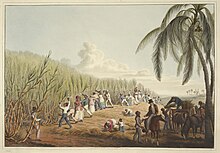George Case (slave trader)
[5] In 1798, Case sent one of his ships called Molly and captained by John Tobin to Angola, where he purchased 436 enslaved people.
Thistlewood routinely beat his forced labourers, raped the women and invented a form of torture called Derby's dose.
The insurance company refused to pay out, and the resulting court case brought the murders to a wide public audience.
[9] In the original case the court found in favour of the slavers and the insurance company was ordered to pay out compensation.
Abolitionists Olaudah Equiano and Granville Sharp launched a campaign and ordered solicitors to begin court action "against all persons concerned in throwing into the sea 133 slaves".
[9] The court cases re-affirmed the right of slavers to murder their victims, however, they are credited with being a legal landmark, because they strengthened public opinion in favour of abolition.
[14] He died at Walton Priory and was buried in Prescot Parish Church where there is a fine monumental brass designed by A. W. N. Pugin[15][16] in his memory.
[18] In 1787, the Liverpool Council became concerned with the growth of the abolition movement and they petitioned Parliament against the regulation of the slave trade.
In 1788, the Liverpool Council stated to Parliament "that the trade had been legally and uninterruptedly carried on for centuries past by many of [H]is Majesty's subjects, with advantages to the country, both important and extensive; but had lately been unjustly reprobated as impolitic and inhuman.
[14] The trust wrote "The Trustees acknowledge that people of colour have been victimised by white privilege for over 400 years", pledging to find ways of making reparations.



